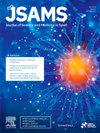Diet, risk of disordered eating and running-related injury in adult distance runners: A systematic review and meta-analysis of prospective cohort studies
IF 3
2区 医学
Q1 SPORT SCIENCES
引用次数: 0
Abstract
Objectives
To determine whether diet and disordered eating risk contribute to running-related injury risk in adult (≥ 18 years) distance runners.
Design
Systematic review and meta-analysis.
Methods
Random effects meta-analyses of prospective cohort studies compared dietary intake and disordered eating risk in distance runners with and without running-related injury. Quality of evidence was assessed using an adapted Grading of Recommendations Assessment, Development and Evaluation approach.
Results
Fifteen studies (n = 5942 runners, 2364 female) were included, with nine studies in the meta-analyses. Moderate certainty evidence indicated injured female runners had lower energy and fat intake than uninjured runners (mean difference [95 % confidence interval] = − 303 kcal/day [− 533, − 73] and − 20 g/day [− 31, − 9], respectively, both p < 0.01). A sex difference was observed for total fat intake (p = 0.01). Moderate certainty evidence suggested injured runners (combined sexes) had lower dietary fibre intake compared to uninjured runners (− 3 g/day [− 5, − 0], p = 0.04). Other dietary factors (protein, carbohydrate, calcium, alcohol intake and disordered eating risk) did not influence injury risk (low–moderate certainty evidence).
Conclusions
Moderate certainty evidence indicates female distance runners with lower energy and total fat intakes are at increased risk of running-related injury, as are runners (combined sexes) with lower dietary fibre intake. Future research should include long duration, high quality prospective cohort studies in male and female runners with clearly defined athletic abilities, consistent injury definition, and standardised statistical analyses.
Review registration: PROSPERO # CRD42022323627.
成年长跑运动员的饮食、饮食失调风险和跑步相关损伤:前瞻性队列研究的系统回顾和荟萃分析。
目的:确定饮食和饮食失调风险是否与成年(≥18 岁)长跑运动员的跑步相关损伤风险有关。设计:系统回顾和荟萃分析。方法:前瞻性队列研究的随机效应荟萃分析比较了有和没有跑步相关损伤的长跑运动员的饮食摄入和饮食失调风险。证据质量采用一种改良的建议分级评估、发展和评价方法进行评估。结果:纳入15项研究(n = 5942 跑步者,2364 女性),其中9项研究纳入meta分析。总能量和总脂肪摄入量存在性别差异(p均 = 0.01)。中等确定性证据表明,受伤的女性跑步者的能量和脂肪摄入量低于未受伤的跑步者(平均差值[95 %置信区间] = -449 kcal/day[-696, -202]和-20 g/day[-31, -9]),两者均为p 结论:中等确定性证据表明,能量和总脂肪摄入量较低的女性长跑运动员发生跑步相关损伤的风险增加,而膳食纤维摄入量较低的跑步者(不分性别)也是如此。未来的研究应包括长时间、高质量的前瞻性队列研究,研究对象为具有明确运动能力、一致损伤定义和标准化统计分析的男性和女性跑步者。审查注册:PROSPERO # CRD42022323627。
本文章由计算机程序翻译,如有差异,请以英文原文为准。
求助全文
约1分钟内获得全文
求助全文
来源期刊
CiteScore
7.40
自引率
10.00%
发文量
198
审稿时长
48 days
期刊介绍:
The Journal of Science and Medicine in Sport is the official journal of Sports Medicine Australia (SMA) and is an an international refereed research publication covering all aspects of sport science and medicine.
The Journal considers for publication Original research and Review papers in the sub-disciplines relating generally to the broad sports medicine and sports science fields: sports medicine, sports injury (including injury epidemiology and injury prevention), physiotherapy, podiatry, physical activity and health, sports science, biomechanics, exercise physiology, motor control and learning, sport and exercise psychology, sports nutrition, public health (as relevant to sport and exercise), and rehabilitation and injury management. Manuscripts with an interdisciplinary perspective with specific applications to sport and exercise and its interaction with health will also be considered.

 求助内容:
求助内容: 应助结果提醒方式:
应助结果提醒方式:


